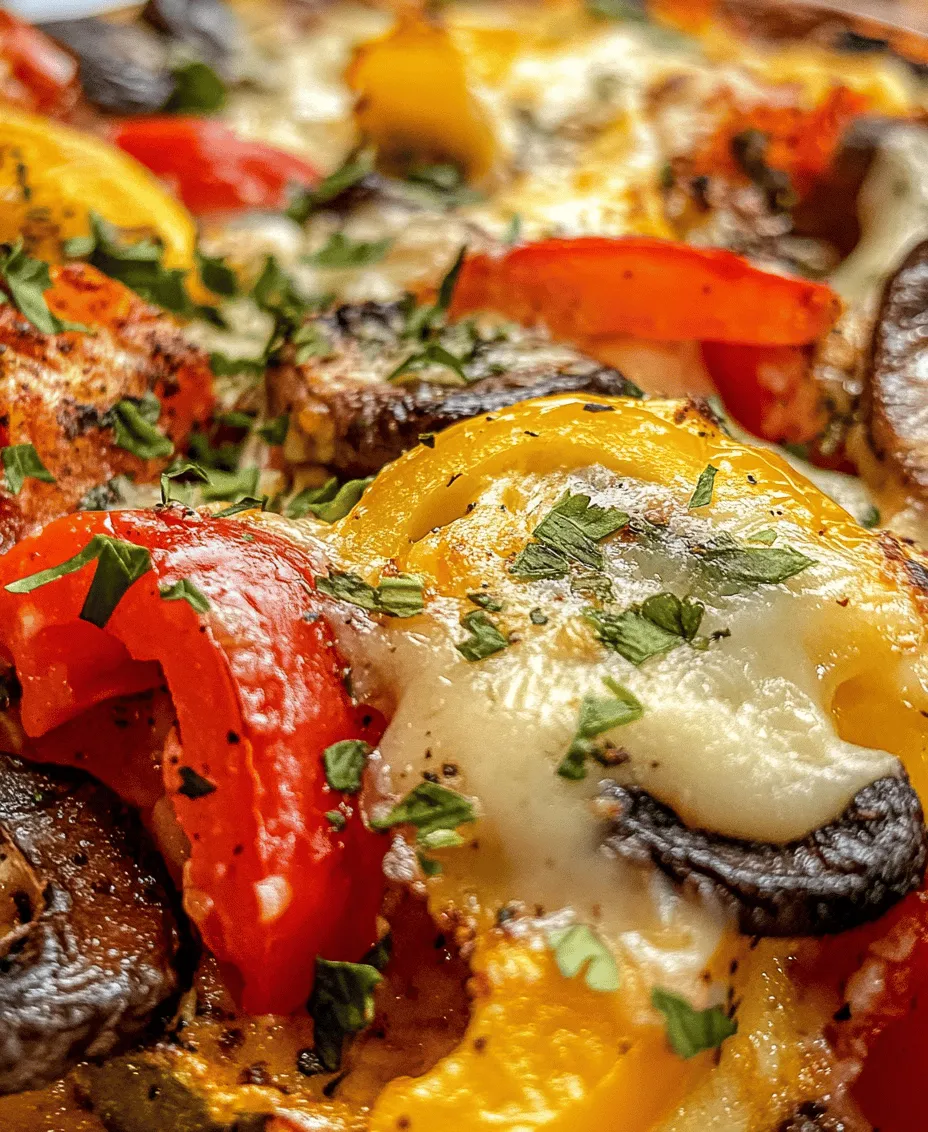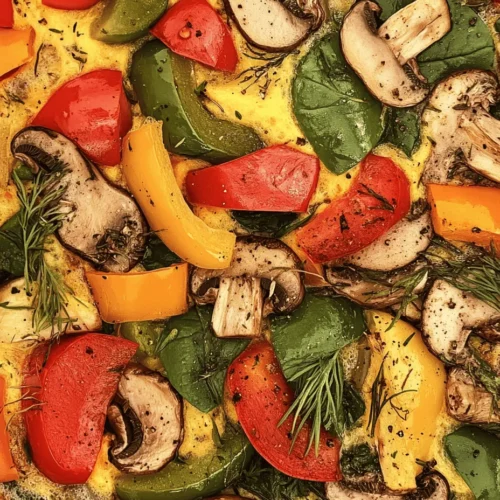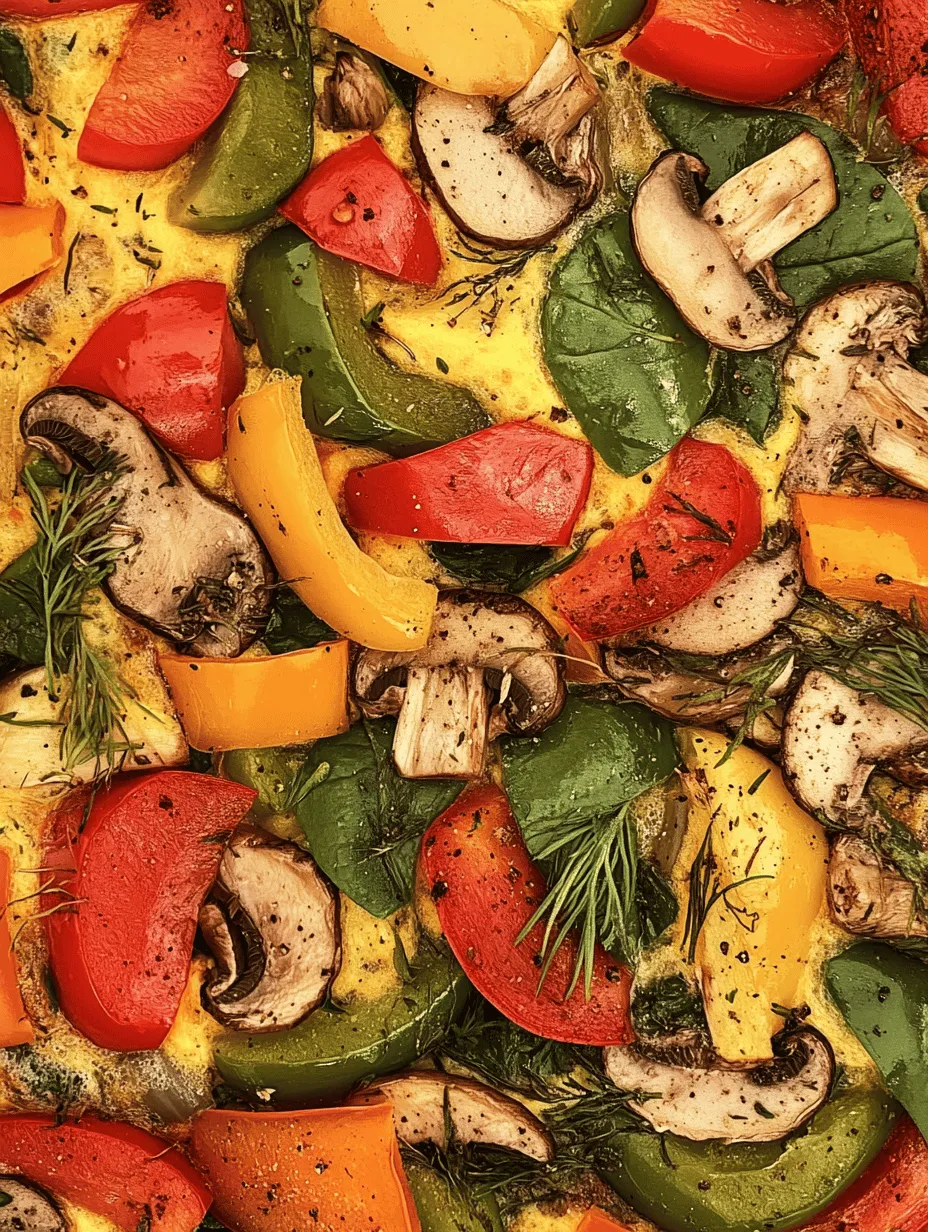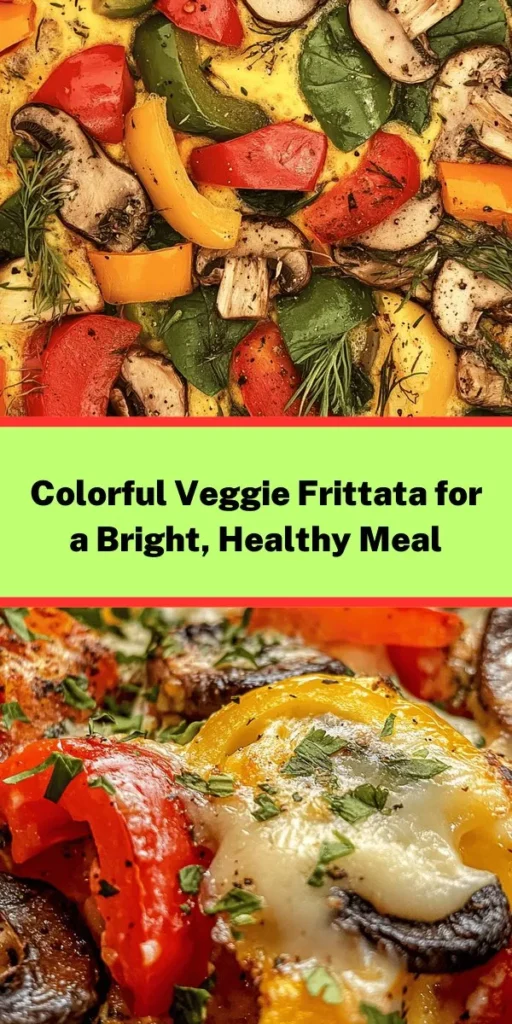Introduction
Frittatas have become a staple in kitchens around the world, celebrated for their versatility and ease of preparation. This delicious egg-based dish can be enjoyed for breakfast, brunch, lunch, or even dinner, making it an adaptable option for any meal of the day. The beauty of a frittata lies not only in its simplicity but also in its ability to showcase an array of colorful vegetables, turning a humble dish into a vibrant feast for the eyes. Whether you are hosting a brunch with friends, preparing a quick weeknight dinner, or simply seeking a nutritious meal, the colorful veggie frittata is sure to impress.
One of the most appealing aspects of this dish is its nutritional profile. The colorful vegetables used in a frittata offer a wealth of vitamins, minerals, and antioxidants, making it an excellent choice for those looking to boost their intake of essential nutrients. From bell peppers to spinach, each ingredient contributes to a balanced diet, while the eggs provide a hearty source of protein. Moreover, this dish caters to various dietary preferences, as it can easily be made vegetarian and gluten-free, making it an inclusive option for diverse eaters.
Understanding Frittatas
Before diving into the details of this vibrant veggie frittata recipe, it’s important to understand what a frittata is and how it differs from other egg-based dishes like omelets and quiches. A frittata is an Italian dish that consists of beaten eggs cooked with various ingredients, typically vegetables, meats, or cheeses. Unlike an omelet, which is folded and often cooked on the stovetop, a frittata is cooked slowly over low heat and usually finished in the oven. This method allows the ingredients to meld together, creating a harmonious blend of flavors.
Frittatas have a rich history rooted in Italian cuisine, where they have been enjoyed for centuries. Traditionally, they were a way to use up leftover ingredients, making them a practical choice for home cooks. Over time, this dish has gained popularity beyond Italy, with variations appearing in many cultures around the world. Today, frittatas are celebrated not only for their practicality but also for their ability to highlight seasonal produce and accommodate a variety of dietary needs.
The frittata’s versatility is one of its key selling points. It can be served warm or at room temperature, making it perfect for gatherings and picnics. The dish can be customized based on personal preferences and the availability of ingredients, allowing for endless creativity in the kitchen. Whether you prefer a classic combination of vegetables or want to experiment with unique flavors, the frittata is a canvas waiting for your culinary touch.
Nutritional Benefits of Ingredients
The colorful veggie frittata features a variety of key ingredients, each offering its own unique health benefits. Understanding these benefits can help you appreciate the nutritional value of this dish, making it not just delicious, but also a smart choice for your diet.
Eggs
At the heart of every frittata are eggs, which serve as a primary protein source. Eggs are rich in essential nutrients, including vitamin B12, riboflavin, and selenium. They also contain choline, which is crucial for brain health. The protein content in eggs can help keep you feeling full and satisfied, making them an excellent choice for those looking to maintain a healthy weight.
Bell Peppers
Bell peppers add a burst of color and flavor to the frittata. These vibrant vegetables are low in calories and packed with vitamins, particularly vitamins A and C. Vitamin A supports eye health and immune function, while vitamin C acts as a powerful antioxidant, helping to protect your body from free radicals. Bell peppers are also a good source of fiber, promoting digestive health.
Spinach
Spinach is another powerhouse ingredient in this frittata. This leafy green is known for its high iron content, which is essential for oxygen transport in the body. Spinach is also rich in vitamins A, C, and K, along with various antioxidants that contribute to overall health. The addition of spinach not only enhances the nutritional profile of the frittata but also adds a lovely green hue.
Mushrooms
Mushrooms are a low-calorie, nutrient-dense food that can enhance the flavor of any dish. They are a good source of B vitamins, including riboflavin, niacin, and pantothenic acid, which are important for energy production. Mushrooms also contain minerals such as selenium, copper, and potassium. Their umami flavor adds depth to the frittata, making it a satisfying meal option.
Cheese
For those who enjoy a creamy texture, cheese is a delightful addition to the frittata. It provides calcium and protein, essential for bone health and muscle maintenance. There are various types of cheeses to choose from, each with its own flavor profile, allowing you to customize your frittata to your taste. However, if you’re following a dairy-free diet, there are plenty of non-dairy cheese alternatives available, which can still provide a similar texture and flavor.
Dairy vs. Non-Dairy Milk
When it comes to making a frittata, the choice between dairy and non-dairy milk can influence the final outcome. Traditional recipes often call for cow’s milk, which adds creaminess and richness. However, for those who are lactose intolerant or prefer plant-based options, non-dairy milks such as almond, soy, or oat milk can be excellent substitutes. These alternatives can provide a similar texture while accommodating various dietary restrictions.
Ingredients Breakdown
Now that we’ve established the nutritional benefits of the key ingredients, it’s time to break down the specific components needed for this colorful veggie frittata. Using fresh produce is essential for enhancing both flavor and nutrition, so be sure to source high-quality ingredients.
Ingredients List
– 6 large eggs: The foundation of the frittata, providing protein and essential nutrients.
– 1 cup bell peppers (diced): Use a mix of colors like red, yellow, and green for visual appeal and flavor.
– 1 cup spinach (fresh and chopped): Adds a nutritious green element to the dish.
– 1 cup mushrooms (sliced): Choose your favorite variety, such as cremini or button mushrooms.
– 1/2 cup cheese (grated): Opt for a cheese that melts well, like mozzarella or cheddar, or try a dairy-free option.
– 1/4 cup milk (dairy or non-dairy): Adds creaminess to the eggs.
– 1 tablespoon olive oil: For sautéing the vegetables and preventing sticking.
– Salt and pepper: To taste.
Substitutions and Variations
One of the great features of a frittata is its flexibility. If you don’t have some of the ingredients on hand, consider these substitutions:
– Vegetables: Feel free to use seasonal vegetables such as zucchini, asparagus, or broccoli instead of bell peppers and mushrooms. The key is to use vegetables that cook well and complement each other.
– Cheese: Experiment with different cheeses to find your favorite flavor. Feta, goat cheese, or even a spicy pepper jack can add a unique twist.
– Herbs: Add fresh herbs like basil, parsley, or chives to enhance the flavor profile.
– Meat: If you’re not strictly vegetarian, consider adding cooked bacon, sausage, or ham for an added layer of flavor and protein.
Incorporating a variety of colors and textures not only makes the frittata visually appealing but also boosts its nutritional content. Using fresh ingredients will result in a more flavorful dish that everyone will love.
Step-by-Step Instructions
Now that you have gathered all the ingredients, it’s time to bring the colorful veggie frittata to life. Below are the step-by-step instructions to ensure your frittata comes out perfectly.
Step 1: Preheat the Oven
Start by preheating your oven to 375°F (190°C). This ensures that the frittata cooks evenly and achieves that perfect golden-brown finish.
Step 2: Sauté the Vegetables
In a large oven-safe skillet, heat the olive oil over medium heat. Once the oil is hot, add the diced bell peppers and sliced mushrooms. Sauté the vegetables for about 5-7 minutes, or until they become tender. Stir occasionally to prevent sticking and ensure even cooking.
Step 3: Add Spinach
Once the bell peppers and mushrooms are ready, add the chopped spinach to the skillet. Cook for an additional 2-3 minutes, stirring until the spinach wilts down. This step enhances the flavor while incorporating a nutritious green element into the frittata.
Step 4: Prepare the Egg Mixture
In a mixing bowl, whisk together the eggs, milk, salt, and pepper until well combined. This mixture will serve as the base of your frittata, binding all the ingredients together.
Step 5: Combine Ingredients
Pour the egg mixture over the sautéed vegetables in the skillet, ensuring that it spreads evenly. Gently stir the mixture to combine the ingredients, allowing the vegetables to be evenly distributed throughout.
Step 6: Add Cheese
Sprinkle the grated cheese evenly over the top of the frittata mixture. This step not only adds creaminess but also enhances the flavor profile, making each bite satisfying and delicious.
Step 7: Cook on the Stovetop
Allow the frittata to cook on the stovetop for about 2-3 minutes. This initial cooking helps set the bottom layer of the frittata, preventing it from sticking to the skillet when transferred to the oven.
Step 8: Transfer to the Oven
Carefully place the skillet in the preheated oven and bake for 15-20 minutes, or until the frittata is puffed up and the eggs are set in the center. You can check for doneness by inserting a toothpick or knife; it should come out clean when the frittata is fully cooked.
As we move towards the conclusion of this part of the article, you are now on your way to creating a delicious and nutritious colorful veggie frittata. Each step plays a vital role in ensuring that your dish is not only flavorful but also visually appealing. Stay tuned for the next section, where we will explore additional tips for achieving the best results with your frittata, as well as answering some common questions related to this delightful recipe.

Clear, Detailed Instructions for Preparing the Frittata
To create a colorful veggie frittata that dazzles both the eyes and the palate, follow these detailed steps:
1. Preheat Your Oven: Begin by preheating your oven to 375°F (190°C). This step is essential as it ensures even cooking and helps achieve that perfect golden-brown top.
2. Prepare Your Ingredients: Gather all necessary ingredients. You’ll need:
– 8 large eggs
– 1/4 cup milk (or a dairy-free alternative)
– 1 cup bell peppers (any color), diced
– 1 cup zucchini, diced
– 1/2 cup red onion, diced
– 1 cup spinach, roughly chopped
– 1 teaspoon garlic powder
– 1 teaspoon salt
– 1/2 teaspoon black pepper
– 1 cup shredded cheese (optional)
– Olive oil or butter for cooking
3. Sauté the Vegetables: In an oven-safe skillet, heat a tablespoon of olive oil over medium heat. Add the diced onion and sauté for about 2-3 minutes, until it becomes translucent. Next, add the bell peppers and zucchini, cooking for an additional 5-7 minutes until they soften. Finally, stir in the spinach and cook until wilted, about 2 minutes. Remove the skillet from heat and let the vegetables cool slightly.
4. Whisk the Eggs: In a large bowl, crack the eggs and whisk them vigorously. For a fluffy frittata, add the milk, garlic powder, salt, and black pepper. Whisk until the mixture is frothy, ensuring that the eggs are well combined and aerated.
5. Combine Eggs and Vegetables: Pour the egg mixture over the sautéed vegetables in the skillet. If you’re using cheese, sprinkle it evenly over the top. Gently stir to distribute the ingredients without undermining the integrity of the whisked eggs.
6. Bake the Frittata: Transfer the skillet to the preheated oven. Bake for 20-25 minutes, or until the frittata is set in the center and lightly golden on top. You can check for doneness by inserting a knife into the center; it should come out clean.
7. Cooling and Serving: Once done, remove the frittata from the oven and let it cool for about 5 minutes before slicing. This resting period helps the frittata set even more and makes slicing easier.
Tips for Whisking Eggs for Fluffiness
– Use Fresh Eggs: Fresh eggs create a better texture and flavor. Check the sell-by date and choose eggs that are still within their freshness window.
– Vigorously Whisk: Use a large whisk and beat the eggs until they are frothy. This incorporates air, which results in a fluffier frittata.
– Add Liquid: Incorporating a small amount of milk or cream into the eggs can enhance their fluffiness. The liquid creates steam during cooking, giving the frittata a light texture.
Techniques for Sautéing Vegetables to Maximize Flavor
– Cut Uniformly: Chop your vegetables into similar-sized pieces to ensure even cooking. This improves texture and presentation.
– Don’t Crowd the Pan: If your skillet is too crowded, the vegetables will steam instead of sautéing. Sauté in batches if necessary.
– Season as You Go: Adding a pinch of salt while sautéing helps draw out the moisture and flavor from the vegetables. This technique enhances their taste before they even reach the egg mixture.
Importance of Using an Oven-Safe Skillet
Using an oven-safe skillet is crucial for this recipe, as it allows for seamless transition from stovetop to oven. Cast iron, stainless steel, and some non-stick skillets are great options. Ensure that your skillet is oven-safe up to the desired temperature (375°F) for best results.
Visual Cues for Each Step
– Sautéing Vegetables: Look for the onions to become translucent and the other vegetables to soften. They should not be browned excessively, as this can lead to a bitter taste.
– Whisked Eggs: The mixture should appear frothy and slightly pale in color after whisking, indicating enough air has been incorporated.
– Baking: The frittata is done when the edges start to pull away from the skillet, and the center is set but not dry.
Baking Techniques for Perfecting Your Frittata
Preheating the oven is vital for the baking process. A well-preheated oven ensures that the frittata cooks evenly and efficiently. The cooking time may vary slightly depending on your oven’s performance, so keep an eye on the frittata as it bakes.
Understanding the Baking Process
As the frittata bakes, the eggs will solidify, and the top will become golden brown. To check for doneness, gently shake the skillet; the frittata should not jiggle significantly. If a knife inserted into the center comes out clean, your frittata is ready.
Tips for Achieving a Golden-Brown Top and Fluffy Texture
– Broil for Extra Color: If you desire a deeper golden color, turn on the broiler for the last 2-3 minutes of cooking. Watch closely to avoid burning.
– Avoid Overbaking: Overbaking can lead to a dry and tough texture. Remove the frittata from the oven as soon as it is set.
Serving Suggestions
The colorful veggie frittata can be served in various delightful ways:
– Garnishing Ideas: Top your frittata with fresh herbs such as parsley, chives, or basil. A sprinkle of additional cheese or a dollop of sour cream can add flavor and richness.
– Suggested Pairings: Serve alongside a light salad of mixed greens, slices of toasted sourdough bread, or roasted potatoes for a complete meal.
– Occasions: This frittata is versatile enough for brunch, lunch, or as a light dinner. Its vibrant colors make it an attractive centerpiece for any dining table.
Storage and Reheating
Properly storing your leftover frittata can help maintain its flavor and texture:
– Best Practices for Storing Leftovers: Allow the frittata to cool completely before transferring it to an airtight container. Store it in the refrigerator for up to 3-4 days.
– Reheating Tips: To reheat, place slices in a preheated oven at 350°F (175°C) for about 10-15 minutes, or until heated through. Avoid microwaving, as it can make the frittata rubbery.
– Freezing Options: If you wish to store it for longer, the frittata can be frozen. Wrap slices tightly in plastic wrap and place them in a freezer-safe container. Thaw in the refrigerator overnight before reheating.
Conclusion
The colorful veggie frittata is not only a feast for the eyes but also a canvas for creativity in the kitchen. Its versatility allows you to experiment with various vegetables and flavors, making it an excellent choice for meal planning. Whether served for breakfast, lunch, or dinner, this frittata can easily fit into a balanced diet.
Encouragement to try different ingredients encourages exploration in the kitchen. Consider adding ingredients like mushrooms, asparagus, or even cooked quinoa for added nutrition and flavor. The colorful veggie frittata is a dish that fits into any occasion, making it a staple in your culinary repertoire. Enjoy the process of making it, and let your taste buds guide your choices!



